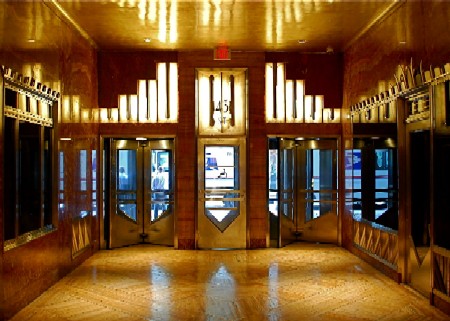
Zigzag Moderne - An Art Deco Subcategory
In the US, the term Zigzag Moderne is sometimes applied to the beginning of Art Deco style. I often use the term 'Art Deco' to refer to the styles of the 1920s (particularly 1925-1929 in the United States) and 'Streamline Moderne' to refer to the styles of the 30s. However, Art Deco is sort of a generic term and is used to refer to designs from the 20s and 30s styles as well as some of the 1940s.
Zigzag Moderne is a term created by David Gebhard to describe the Art Deco architecture of Minnesota built from 1920 through roughly 1930. Fortunately, his description of the characteristics of this style contains enough information to make it useful to describe decor as well. So let's take a look at his characteristics for Zigzag Moderne, modified slightly so it applies to interior design.

Zigzag Modern, Lobby of the Chrysler Building, Vertical Bias, Chevrons,
Stepped Design, Architect: William Van Allen, 1930, Wikimedia
- Smooth Surfaces with a Vertical Orientation - A tenet of Modernism is to remove excess ornamentation.
- Symmetry and Balance.
- Stepped Patterns - Stepping appears in a variety of 1920s designs. Bases of furniture, platforms, lamps and other furniture are often stepped. Ziggurat designs frequently appear in 1920s as do stepped fan designs.
- 'Formal', 'Heavy' and 'Monumental' Designs - Furniture in the 1920s often looks very solid and weighty. Much of the furniture is quite sturdy looking.
- Select Ornamentation - This often features the eponymous zigzags as well as chevrons, sunbursts, spirals, along with stylized plants and animals.
(Reference: David Gebhard, A Guide to the Architecture of Minnesota, 1977, p. 419)
Note that while the features of Streamline Moderne embrace Modernism even more than Zigzag Moderne, they are still more ornamental and make use of 'unnecessary' design elements not found in the stricter 'form follows function' mantra of the Modernists.
Of course, these are just guidelines. The furniture of the 1920s runs the gamut of design and you will almost certainly find examples which disagree with some of the points mentioned. In addition, different countries had different ideas about what represented the Modernist style during the 1920s. (Some French furniture from this period has delicate, tapered legs reminiscent of Midcentury Modern designs rather than the stolid legs suggested above.)
Original Facebook Group Posting
 Zigzag Moderne Furniture, from left - Telephone Table and Chair, Ebonized Walnut and Maple Marquetry, attr Abel Faidy, c1927. Minneapolis Institute of Art; Six Panel Screen, Wood, attr. Donald Deskey, Artnet; Zigzag Buffet, Beech Frame With Elm, Walnut, Rosewood and Asian Mahogany Marquetry, French, Modern, HT Deco
Zigzag Moderne Furniture, from left - Telephone Table and Chair, Ebonized Walnut and Maple Marquetry, attr Abel Faidy, c1927. Minneapolis Institute of Art; Six Panel Screen, Wood, attr. Donald Deskey, Artnet; Zigzag Buffet, Beech Frame With Elm, Walnut, Rosewood and Asian Mahogany Marquetry, French, Modern, HT Deco